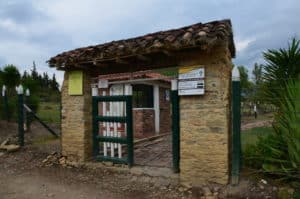Last updated on .
Just outside of Villa de Leyva and not too farm from the Fossil Museum (Museo El Fósil) are El Infiernito and Sol Muisca. They are two places to visit that are related to the indigenous Muisca people who once lived in Boyacá.
El Infiernito
El Infiernito, officially named Villa de Leyva Archaeological Park (Parque Arqueológico Villa de Leyva), is an archaeological site that was once a Muisca observatory. It’s open Tuesday to Sunday from 9am to noon and 2pm to 5pm. Admission is COP$8,000 (as of June 2020). A guide is on-site for those who want more information (in Spanish).

The Muisca created a field of monoliths arranged in rows from east to west. They held important religious festivals related to fertility at the site and also used it as an astronomical observatory. They were able to observe the solstices and equinoxes from the site. For example, the summer solstice sun rose in the exact spot to the east where the sacred Laguna de Iguaque is located.
When the Spanish arrived, they deemed the Muisca celebrations as ungodly and named it “El Infiernito”, or “Little Hell”, and destroyed the site.
Behind the observatory are several phallic monoliths placed in a field. They represented life and fertility. The Muisca believed that the monoliths would bring good harvests.
Finally, there’s an empty tomb with two rows of stones in front of the entrance. A tomb in such a sacred place was reserved for those of high social or spiritual rank. However, an expert told me that it was probably not a tomb at all because no human remains were ever found inside.
Sol Muisca (Permanently Closed)
Across from El Infiernito is Sol Muisca. If it’s open, it’s an excellent place to learn about Muisca culture. Guides give an interesting talk that takes about 45 minutes. (Note: Sol Muisca has been turned into a hotel.)
The talk began at a small circular observatory, where the guide taught us how the Muisca observed the solstices and equinoxes. She spoke a bit about El Infiernito across the street and how it was used.
Next, we entered a small replica Muisca hut where we learned everything about Muisca daily life. The guide told us about their gods and rituals, what they ate, how they lived, their social classes, and about different sites around Colombia sacred to the Muisca. There was even a display about Muisca words that have made their way into Colombian Spanish.
Conclusion
We were very impressed by our experience at Sol Muisca. It was mush better than we expected it to be and are happy we visited. We listened to the guide at El Infiernito and thought the information we received at Sol Muisca was much more complete. I actually recommend visiting Sol Muisca before El Infiernito in order to get a better understanding of the Muisca and the importance of the site.
Getting There
To get to Sol Muisca and El Infiernito, you can take any bus from Villa de Leyva heading to Santa Sofía. Ask the driver to let you off at the road to El Infiernito. It’s a long walk down a gravel road to the site. You can also hire a taxi for the day to take you there and other nearby point of interest.